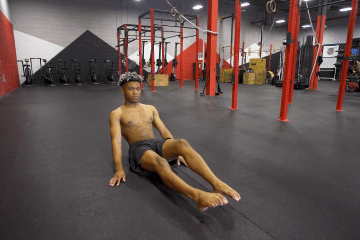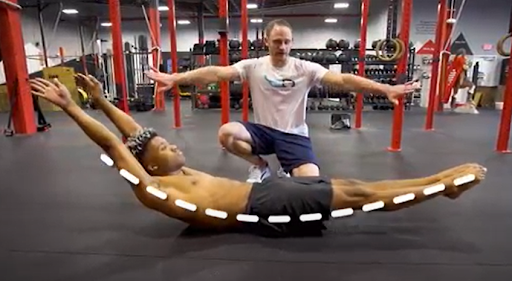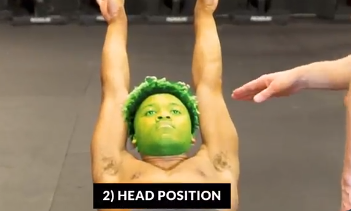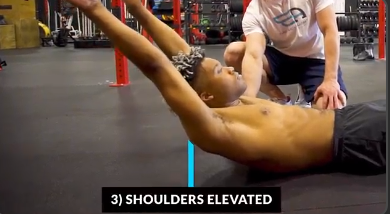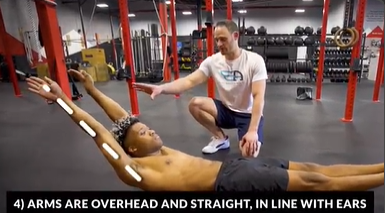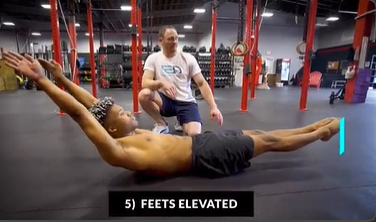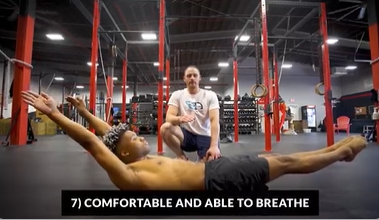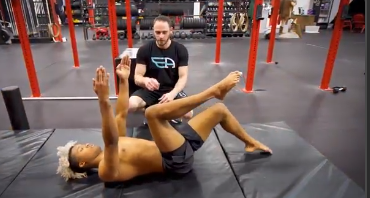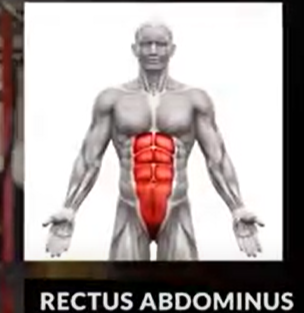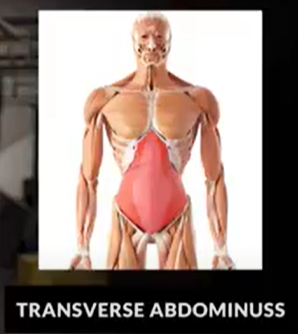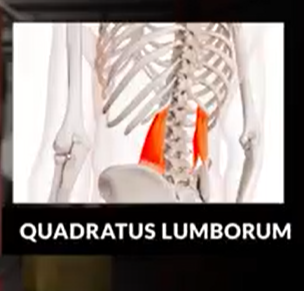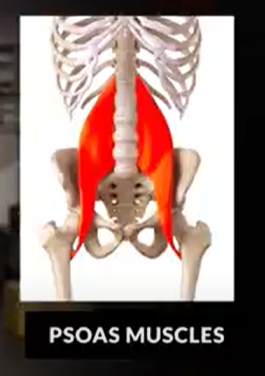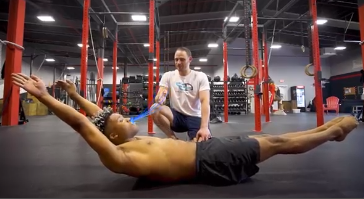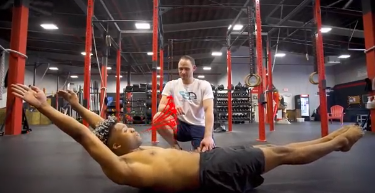😱Ever wondered what elevates a seemingly simple position like the hollow hold into a cornerstone of athletic prowess?
The hollow hold may seem deceptively simple at first glance, but its impact on athletic performance is profound. This core-strengthening exercise isn’t just about holding a position—it’s a gateway to unlocking a myriad of benefits.
🏆From enhancing stability and balance to fortifying the core muscles crucial for various sports movements, the hollow hold acts as a linchpin in building overall athleticism and physical resilience.
Its ability to engage multiple muscle groups simultaneously, including those often neglected, makes it a fundamental exercise for anyone aiming to excel in sports or achieve a higher level of fitness.
Let’s delve deeper into the anatomy and mechanics behind this seemingly straightforward yet incredibly impactful exercise.👊
✨What is Hollow Hold?
The hollow hold is a foundational core exercise used in various fitness routines and sports training. It involves lying on your back and lifting your upper and lower body off the ground, creating a “hollow” shape by engaging your core muscles to maintain a stable position.
This position requires engaging your abdominal muscles to create a slight arch in your lower back, keeping your lower back pressed against the floor while lifting your legs and shoulders off the ground. The goal is to maintain this position, keeping your core muscles engaged and your body stable, which helps strengthen your core and improve overall stability.
Related article: 📍Having Trouble with Hollow Holds? Try These Regressed Versions
🔥🔥 7 Areas that Make the Hollow Hold Perfect
So, what exactly makes a hollow hold perfect? A perfect hollow hold goes beyond just holding the position; it’s about achieving and maintaining a specific form that maximizes its effectiveness. Here’s what constitutes a great hollow hold:
1. 🎯 Body Position: Long and Curved
In the hollow hold, focus on keeping your body in a long, continuous curve and avoid a hip hinge.
In the hollow hold, avoiding a hip hinge is crucial. It occurs when the legs lift too high, disrupting the desired curved body shape. Keeping the legs slightly lower maintains the smooth, rounded posture required for proper form in the hollow hold, ensuring effective core engagement without compromising alignment.
2. 🎯 Head Position
The head position in a hollow hold is essential for maintaining proper alignment and engaging the entire body effectively.
Aim for a lengthened position, almost like a gentle chin tuck. Keep your head in line with your spine, elongating your neck rather than tucking it in too much.
By ensuring your head stays long and in alignment with your spine, you distribute the workload evenly throughout your core without putting unnecessary strain on your neck or upper body. It’s about finding that balance between elongation and alignment for a more effective and comfortable hollow hold.
3. 🎯 Shoulder Elevated
In the hollow hold, it’s noticeable that the shoulders aren’t resting on the floor—they’re intentionally elevated. This position is essential for maintaining engagement in the core muscles and preventing the upper body from completely relaxing onto the ground. It ensures continuous work for the core, making the hold more dynamic and effective.
By keeping the shoulders elevated, you create a more dynamic and challenging hollow hold, emphasizing the need for core strength and endurance. It’s a deliberate adjustment that adds intensity to the exercise and helps sustain the engagement of the core muscles throughout the movement.
4. 🎯 Arms Position
Your arms should be extended overhead, aligned with your ears. This elongated arm position complements the straight line of the body, enhancing the challenge for your core muscles to maintain stability.
5. 🎯 Feets Elevated
The feet are intentionally raised about five to six inches off the floor. This elevation is part of the challenge, requiring more engagement from your core muscles to maintain the position.
Keeping the feet elevated intensifies the exercise, adding difficulty and emphasizing the need for greater core strength and stability to sustain the hold.
6. 🎯 Core is Braced
Focusing on the core is crucial in a hollow hold. You want to brace the entire core, ensuring a 360-degree engagement around the midsection. A key visual cue for proper form is feeling the lower back making contact with the floor. If there’s space between your lower back and the ground, it indicates incorrect engagement.
When the lower back isn’t in contact with the floor and there’s enough space to slide a hand underneath, it signifies an arched position that doesn’t utilize the necessary pelvic tilt motion. This lack of contact indicates improper engagement, leading to ineffective core activation.
By emphasizing the importance of maintaining contact between the lower back and the floor, you ensure the correct engagement of core muscles and utilization of the pelvic tilt, creating the foundation for proper form and effective muscle activation in the hollow hold exercise.
7. 🎯 Comfortable and Able to Breathe
Comfort and the ability to breathe comfortably are vital aspects when doing hollow golds. When performing this exercise, it’s crucial to maintain a relaxed facial expression and ensure the ability to breathe deeply, especially through belly breathing.
If you’re comfortably positioned and breathing naturally, it indicates that you’ve found a sustainable form that you can own and maintain for longer periods. This relaxed state allows for better endurance and control in holding the position effectively.
However, if you find it challenging to maintain comfort or struggle to breathe properly during the hold, it’s a sign that the exercise might break down. When discomfort or difficulty breathing arises, the brain prioritizes the need for oxygen, potentially compromising the form and engagement of the core.
It’s essential to strike a balance where you can remain stable, maintain proper core engagement, and sustain the position through controlled breathing. Both stability and breath work are equally important for an effective and sustainable hollow hold. If needed, regressing or adjusting the position can help find that balance between core stability and comfortable breathing.
And don’t miss the chance to check out the awesome video about doing a perfect hollow hold: Hollow Hold Perfection | Crack the Code to Core Strength
⚡️Prerequisites for Mastery
To prepare for mastering the hollow hold, several prerequisites lay the groundwork for achieving this core-strengthening position. Understanding and honing these foundational elements are pivotal.
Dead Bug Exercises
Firstly, exercises like the dead bug and its variations serve as crucial preparatory steps. These movements not only teach core engagement but also emphasize the elongation of the body—an essential component for the hollow hold.
They help in comprehending how to activate the entire core while maintaining body length and alignment, fundamental aspects needed for a successful hollow hold.
Segmented Practice
Furthermore, breaking down the hollow hold into segmented parts aids in focusing on specific areas. Practicing upper body lifts or lower body lifts while holding the hollow position isolates and strengthens targeted muscle groups.
This segmentation technique allows individuals to concentrate on particular aspects of the hold, gradually building strength and control in those specific regions.
💪Muscles Engaged
During a hollow hold, a diverse range of muscles within the abdomen and surrounding areas actively engage to maintain the position and stability required. The following muscles play a significant role:
- 👊Rectus Abdominis
Known as the “six-pack” muscles, these run vertically along the front of the abdomen and aid in flexing the spine.
- 👊Transverse Abdominis
This deep-lying muscle wraps around the abdomen, providing core stability and compressing the abdominal contents.
- 👊Obliques
Divided into internal and external obliques, oblique muscles help in rotation and side-bending of the torso, contributing to core strength and stability.
- 👊Quadratus Lumborum
Located in the lower back, quadratus lumborum supports lateral flexion and stabilization of the spine and pelvis.
- 👊Psoas Muscles
These hip flexor muscles connect the spine to the lower body, assisting in lifting the legs and stabilizing the trunk.
- 👊Glutes
Engaging the gluteal muscles adds to the overall stability and alignment of the pelvis and lower back during the hollow hold.
The hollow hold’s effectiveness stems from its ability to target and engage this array of muscles comprehensively. By targeting these muscles simultaneously, the exercise contributes to strengthening the entire core region, including the abdominals, obliques, lower back, and hip flexors.
💯Breathing Technique
The breathing technique during a hollow hold is crucial for maintaining stability and control while holding the static position.
- ✊ Normal Breathing Pattern: Ideally, during the hollow hold, aim for a normal breathing rhythm. Even though it’s a static position and you’re not changing posture, maintaining a consistent breathing pattern is key.
- ✊ Indicator of Position Mastery: If you can maintain this regular breathing pattern comfortably throughout the hold, it indicates mastery of the position. This means you have sufficient control and engagement of your core muscles without compromising your breath.
- ✊ Addressing Breath-Holding: If you find yourself holding your breath during the hollow hold, it could suggest excessive strain or difficulty in maintaining the position. In such cases:
- Adjust by modifying the position slightly, such as bending the hips, legs, or arms, to reduce the intensity and make it more manageable.
- This modification aims to make the hollow hold slightly easier while still engaging the core muscles.
- Revert to a regular breathing pattern while ensuring continuous engagement of the core muscles.
🎯The goal is to sustain a steady and controlled breathing pattern throughout the hollow hold. If breath-holding occurs, it’s a signal to adjust the position slightly to regain comfort while still engaging the core effectively. This technique ensures that while maintaining the hold, you’re not compromising your breathing but rather optimizing core engagement and control.
Related article: 📍The Proper Way to Breath during Exercise to Maximize Performance
🏆Benefits of Mastery
Mastering the hollow hold reaps numerous benefits, extending far beyond the immediate improvement in core strength. Here are the benefits of mastering the hollow hold:
-
✅ Back Pain Alleviation
A strong core, developed through mastering the hollow hold, contributes significantly to alleviating back pain.
The strengthened core muscles, including the abdominals, obliques, and lower back, provide crucial support and stability to the spine. This support helps reduce the risk of back pain by enhancing spinal alignment and minimizing strain on the back muscles during daily activities.
-
✅ Enhanced Core Strength
The hollow hold, when mastered, effectively targets and strengthens the deep core muscles. This comprehensive engagement not only fortifies the superficial abdominal muscles but also the deeper core stabilizers, fostering a well-rounded core strength crucial for overall stability and balance.
-
✅ Progression to Higher-Level Skills
Mastery of the hollow hold serves as a foundational skill for advancing to higher-level movements in various activities, such as gymnastics or functional fitness. It forms the basis for mastering advanced techniques like kipping movements, muscle-ups, or bar work by providing the requisite core stability and control necessary for these challenging skills.
-
✅ Improved Athletic Performance
Incorporating the hollow hold into a training regimen enhances overall athletic performance. Its ability to strengthen core muscles vital for dynamic movements translates to improved agility, balance, and coordination, factors crucial for excelling in sports and physical activities.
-
✅ Postural Improvement
The core strength gained from mastering the hollow hold contributes to better posture. Strengthened core muscles provide the foundation for maintaining proper alignment, reducing the likelihood of poor posture-related issues.
-
✅ Injury Prevention
A strong core developed through mastering the hollow hold is a protective mechanism against injuries, particularly those related to lower back and core instability. This reduced risk of injury is invaluable in maintaining an active and healthy lifestyle.
Related article: 📍5 Little-Known Secrets to Prevent Injuries in Sports like Calisthenics
🧐Frequently Asked Questions
🔎Are there variations of the hollow hold?
Yes, variations exist for different skill levels. Besides the standard hollow hold, variations include bent-knee hollow holds or adding movements like flutter kicks or scissor kicks to increase difficulty.
🔎Can I do hollow holds every day?
While the exercise is beneficial, allowing muscles adequate rest is crucial. Aim for 2-3 sessions per week with rest days in between.
🔎What if I feel lower back strain during a hollow hold?
Focus on engaging your core more by pressing your lower back into the floor. Adjust your position or try a modified version with knees bent to reduce strain. If discomfort persists, consult a fitness professional.
🔎Will hollow holds help me get a six-pack?
While they strengthen core muscles, visible abs also depend on diet and overall body fat percentage. Hollow holds contribute to core strength and stability, but achieving a six-pack involves a combination of exercise and a balanced diet.
📌Conclusion
🔥The hollow hold might seem simplistic, but its impact on athletic prowess is monumental. It’s not just about holding a position; it’s a gateway to a plethora of benefits. From enhancing stability and strengthening core muscles crucial for athletic movements to engaging neglected muscle groups, it’s fundamental for sports excellence and overall fitness.
Exploring the anatomy and mechanics behind this exercise illuminates its multifaceted effectiveness.
🤯Interested in unlocking your athletic potential through calisthenics like the hollow hold? Take a free assessment 👊 today and discover how mastering foundational exercises like this can transform your fitness journey and elevate your performance to new heights.
Whether you’re an aspiring athlete or aiming for peak physical fitness, The Movement Athlete offers the guidance and expertise to amplify your training and achieve your fitness goals through calisthenics.🤸


